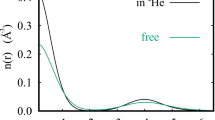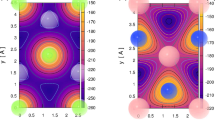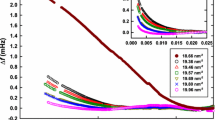Abstract
First principle computer simulations of a thin parahydrogen film adsorbed on a silica substrate at low temperature (below 6 K) yield no evidence that the top layer is liquid and/or in the proximity of a superfluid transition, as claimed in recent experimental work (Makiuchi et al. in Phys Rev Lett 123:245301, 2019). Computed values of first and second layer completion densities are in quantitative agreement with experiment, but as observed also on other substrates, the top layer is an insulating crystal, quantum-mechanical exchanges of molecules are non-existent, and the overall physical behavior of the system can be understood largely along classical lines.



Similar content being viewed by others
Notes
Theoretical evidence suggests that the properties of an adsorbed layer of p-\(\hbox {H}_2\) on the inner surface of a cylinder of such a large diameter, are essentially identical with those on a flat substrate. See, for instance, Ref. [10].
This value is approximately 40% of that on a graphene substrate, for which second layer promotion is predicted to occur at \(\theta \sim 0.112\) \(\AA ^{-2}\) [36].
More quantitatively, we estimate that the fraction of p-\(\hbox {H}_2\) molecules involved in exchange cycles in the most favorable conditions explored here, namely for the top layer of a two-layer film of coverage \(\theta =0.155\) \(\AA ^{-2}\) at a temperature \(T=0,5\) K is less than 0.001%.
It is worth pointing out that even \(^4\)He would crystallize at low temperature, if exchanges were suppressed, as shown in Ref. [24].
Defects are attributable both to the relatively high temperature, as well as the difficulty of fitting two triangular lattices of different density and number of particles, i.e., the two different layers, in the same simulation cell.
References
V.L. Ginzburg, A.A. Sobyanin, JETP Lett. 15, 242 (1972)
M. Bretz, A.L. Thomson, Phys. Rev. B 24, 467 (1981)
G.M. Seidel, H.J. Maris, F.I.B. Williams, J.G. Cardon, Phys. Rev. Lett. 56, 2380 (1986)
M. Rall, J.P. Brison, N.S. Sullivan, Phys. Rev. B 44, 9639 (1991)
M. Schindler, A. Dertinger, Y. Kondo, F. Pobell, Phys. Rev. B 53, 11451 (1996)
P.E. Sokol, R.T. Azuah, M.R. Gibbs, S.M. Bennington, J. Low Temp. Phys. 103, 23 (1996)
A.C. Clark, X. Lin, M.H.W. Chan, Phys. Rev. Lett. 97, 245301 (2006)
M. Boninsegni, Phys. Rev. B 70, 193411 (2004)
M. Boninsegni, Phys. Rev. Lett. 111, 235303 (2013)
T. Omiyinka, M. Boninsegni, Phys. Rev. B 93, 104501 (2016)
A. Del Maestro, M. Boninsegni, Phys. Rev. B 95, 054517 (2017)
J. Turnbull, M. Boninsegni, Phys. Rev. B 78, 144509 (2008)
M. Boninsegni, New J. Phys. 7, 78 (2005)
M. Boninsegni, Phys. Rev. B 93, 054507 (2016)
P. Sindzingre, D.M. Ceperley, M.L. Klein, Phys. Rev. Lett. 67, 1871 (1991)
Y. Kwon, K.B. Whaley, Phys. Rev. Lett. 89, 273401 (2002)
F. Mezzacapo, M. Boninsegni, Phys. Rev. Lett. 97, 045301 (2006)
F. Mezzacapo, M. Boninsegni, Phys. Rev. A 75, 033201 (2007)
M. Boninsegni, J. Low Temp. Phys. 201, 193 (2020)
S. Grebenev, B. Sartakov, J.P. Toennies, A.F. Vilesov, Science 289, 1532 (2000)
H. Li, R.J. Le Roy, P.-N. Roy, A.R.W. McKellar, Phys. Rev. Lett. 105, 133401 (2010)
P.L. Raston, W. Jäger, H. Li, R.J. Le Roy, P.-N. Roy, Phys. Rev. Lett. 108, 253402 (2012)
M. Boninsegni, Phys. Rev. B 97, 054517 (2018)
M. Boninsegni, L. Pollet, N. Prokof’ev, B. Svistunov, Phys. Rev. Lett. 109, 025302 (2012)
T. Makiuchi, K. Yamashita, M. Tagai, Y. Nago, K. Shirahama, Phys. Rev. Lett. 123, 245301 (2019)
D.R. Nelson, J.M. Kosterlitz, Phys. Rev. Lett. 39, 1201 (1977)
M. Boninsegni, Phys. Rev. B 70, 125405 (2004)
M. Dusseault, M. Boninsegni, Phys. Rev. B 95, 104518 (2017)
I.F. Silvera, V.V. Goldman, J. Chem. Phys. 69, 4209 (1978)
L. Pricaupenko, J. Treiner, Phys. Rev. Lett. 74, 430 (1995)
V. Apaja, E. Krotscheck, Phys. Rev. B 67, 184304 (2003)
G. Vidali, G. Ihm, H.-Y. Kim, M.W. Cole, Surf. Sci. Rep. 12, 133 (1991)
M. Boninsegni, S.-Y. Lee, V.H. Crespi, Phys. Rev. Lett. 86, 3360 (2001)
K. Nho, E. Manousakis, Phys. Rev. B 67, 195411 (2003)
M. Boninsegni, J. Low Temp. Phys. 141, 27 (2005)
M. Dusseault, M. Boninsegni, Phys. Rev. B 97, 205403 (2018)
K. Nho, E. Manousakis, Phys. Rev. B 65, 115409 (2002)
R.P. Feynman, Phys. Rev. 91, 1291 (1953)
M. Boninsegni, A.B. Kuklov, L. Pollet, N.V. Prokof’ev, B.V. Svistunov, M. Troyer, Phys. Rev. Lett. 99, 035301 (2007)
M. Boninsegni, M.W. Cole, F. Toigo, Phys. Rev. Lett. 83, 2002 (1999)
F. Fernández-Alonso, C. Cabrillo, R. Fernández-Perea, F.J. Bermejo, M.A. González, C. Mondelli, E. Farhi, Phys. Rev. B 86, 144524 (2012)
Acknowledgements
This work was supported by the Natural Sciences and Engineering Research Council of Canada.
Author information
Authors and Affiliations
Corresponding author
Ethics declarations
Conflict of interest
The author declares that he has no conflict of interest.
Additional information
Publisher's Note
Springer Nature remains neutral with regard to jurisdictional claims in published maps and institutional affiliations.
Rights and permissions
About this article
Cite this article
Boninsegni, M. Quasi-2D \(\hbox {H}_2\): On the Verge of Turning Superfluid?. J Low Temp Phys 202, 1–10 (2021). https://doi.org/10.1007/s10909-020-02548-6
Received:
Accepted:
Published:
Issue Date:
DOI: https://doi.org/10.1007/s10909-020-02548-6




